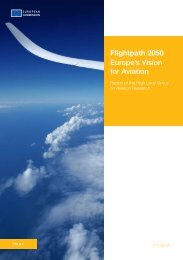Create
Final Report - Acare
Final Report - Acare
- No tags were found...
You also want an ePaper? Increase the reach of your titles
YUMPU automatically turns print PDFs into web optimized ePapers that Google loves.
16<br />
are too great and the realisation of benefits<br />
is uncertain. The aviation community is,<br />
therefore, largely locked into its present<br />
(and past) overall shape because it lacks<br />
adequate mechanisms for enabling change.<br />
The implications are severe. The world is<br />
changing at an unprecedented rate. The<br />
demands of globalisation are being felt<br />
everywhere. The forces of declining fuel<br />
reserves, global warming, and mass migration<br />
move inexorably to create change. Yet the<br />
pattern of air transport cannot alter from its<br />
present character. Some will say that this is a<br />
sign of a mature system having reached, by<br />
a process of evolution, a stable and efficient<br />
character that is well suited to the needs of its<br />
operational environment. But this overlooks<br />
the dramatic changes occurring to the nature<br />
of the evolutionary pressure that produced<br />
the present system over 50 or more years.<br />
The nature of the system needed is changing<br />
and our system is not well prepared for the<br />
extent or rate of change. There is a real risk<br />
of finding in, say, 2050 – 2070 that we have a<br />
system, very highly developed, but optimised<br />
for a world long gone.<br />
To preserve options for the future<br />
that involve more radical, deeper and<br />
discontinuous changes two features must<br />
change. Firstly, we need a mechanism that<br />
will be capable of supporting and funding<br />
research studies into innovatory ideas.<br />
Secondly, we need a group of ideas that will<br />
address the changes that we can see coming.<br />
Without both changes our future scope for<br />
adapting to the future will be handicapped<br />
by lack of preparation. Whilst we shall<br />
move forward, and continue to introduce<br />
less radical and more evolutionary changes,<br />
we shall not address the key issue that the<br />
evolutionary forces are themselves changing<br />
at a pace and scale that must involve the<br />
whole air transport system.<br />
Goals and concepts for the air transport<br />
system of 2050 and beyond need to be<br />
discussed now. Many of the ideas put forward<br />
will not succeed, sometimes because they<br />
are bad ideas but also because some will not<br />
suit the model for aviation adopted for the<br />
future. Only a relatively few concepts for<br />
the future will be successfully adopted. If<br />
we knew which these were to be, we would<br />
need only study these few – unfortunately<br />
we don’t. We can have no confidence in our<br />
ability to predict the future – it has never<br />
been successful and there is little reason to<br />
think that this will change. How then, can we<br />
research new concepts to produce the system<br />
that will succeed the present one if industry<br />
cannot invest in them due to financial<br />
pressure for short term return on investment?<br />
The nature of change management in a<br />
large and complex system is itself complex.<br />
Changes have to be introduced at their<br />
own “economic pace” – the rate at which<br />
work can be done, funds provided and<br />
resources applied. The system will need to<br />
be operable during the change process – it<br />
will have some old and some new parts that<br />
must work safely and effectively alongside<br />
each other. The implications for any radical<br />
change proposal will be very widespread<br />
and will need to be exhaustively studied<br />
before they are seen to be potentially viable<br />
solutions for the future. These implications<br />
will need to embrace the development of<br />
new technologies, new operating models,<br />
new relationships, funding and capital,<br />
the management of transition from the<br />
old to the new, the integration of the new<br />
system and the detailed development of the<br />
concept itself. It is probable that a majority<br />
of the concepts studied will encounter<br />
overwhelming obstacles to their successful<br />
adoption. But, despite this, we need to get<br />
to a stage where a satisfactory portfolio of<br />
options for the future has been studied in<br />
sufficient detail to allow sober judgements<br />
to be made about the investments needed to<br />
take them forward.<br />
This work cannot all be done at once. Even<br />
if we possessed a portfolio of ideas today we<br />
would not know which to choose. We need to<br />
allow the forces of change to exert themselves<br />
further before we do so. We need to sense<br />
the weight that we should attach to each<br />
before we make these major decisions. Will<br />
declining fuel reserves be a major problem or<br />
will other ways of conserving fossil fuel for<br />
particular uses be developed; will globalisation<br />
continue to drive economic prosperity (and<br />
the air travel needs) forward at the rate we<br />
anticipate; will new technologies provide<br />
realistic alternatives to air travel? These and<br />
many other questions will slowly become<br />
clearer and our needs will be shaped as a<br />
consequence. The solutions for future air<br />
travel may be radical, we do not yet know<br />
with any certainty which they will be. They<br />
will probably involve multiple sectors of the<br />
aviation community. If we are to be ready to<br />
make changes when we see the sure need for<br />
them, the work to develop the solutions to be<br />
applied has to have been started in time.



